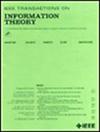Generalized Quantum Data-Syndrome Codes and Belief Propagation Decoding for Phenomenological Noise
IF 2.2
3区 计算机科学
Q3 COMPUTER SCIENCE, INFORMATION SYSTEMS
引用次数: 0
Abstract
Quantum stabilizer codes often struggle with syndrome errors due to measurement imperfections. Typically, multiple rounds of syndrome extraction are employed to ensure reliable error information. In this paper, we consider phenomenological decoding problems, where data qubit errors may occur between extractions, and each measurement can be faulty. We introduce generalized quantum data-syndrome codes along with a generalized check matrix that integrates both quaternary and binary alphabets to represent diverse error sources. This results in a Tanner graph with mixed variable nodes, enabling the design of belief propagation (BP) decoding algorithms that effectively handle phenomenological errors. Importantly, our BP decoders are applicable to general sparse quantum codes. Through simulations, we achieve an error threshold of more than 3% for quantum memory protected by rotated toric codes, using solely BP without post-processing. Our results indicate that d rounds of syndrome extraction are sufficient for a toric code of distance d. We observe that at high error rates, fewer rounds of syndrome extraction tend to perform better, while more rounds improve performance at lower error rates. Additionally, we propose a method to construct effective redundant stabilizer checks for single-shot error correction. Our simulations show that BP decoding remains highly effective even with a high syndrome error rate.求助全文
约1分钟内获得全文
求助全文
来源期刊

IEEE Transactions on Information Theory
工程技术-工程:电子与电气
CiteScore
5.70
自引率
20.00%
发文量
514
审稿时长
12 months
期刊介绍:
The IEEE Transactions on Information Theory is a journal that publishes theoretical and experimental papers concerned with the transmission, processing, and utilization of information. The boundaries of acceptable subject matter are intentionally not sharply delimited. Rather, it is hoped that as the focus of research activity changes, a flexible policy will permit this Transactions to follow suit. Current appropriate topics are best reflected by recent Tables of Contents; they are summarized in the titles of editorial areas that appear on the inside front cover.
 求助内容:
求助内容: 应助结果提醒方式:
应助结果提醒方式:


